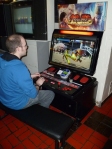 While I was growing up, I subscribed to Tips & Tricks magazine. Like most kids I was drawn in with the last half of magazine being dedicated to cheat codes and hints for all my games. Even better was when they pushed out one of their “Code Books” which ditched every written article entirely to house just these cheats. While I was a fan of the codes, I would pretty much read the magazine front to back because there wasn’t any internet in our house to occupy my time otherwise, so this was my only means of gaming related news each month. Being into fighting games since Mortal Kombat II, I was attracted to the one or two page monthly feature ranking the best fighting game players in the US and the rest of the world. These were names that you still hear today, like Ricky Ortiz, Justin Wong, and the phenomenon that is Daigo Umehara. One thing I noticed about some of these players was their location: California. Specifically Sunnyvale, California. In my mind I pegged the cute sounding city as a Mecca for video game arcade fighting. As luck would have it, I happened to fall in love with a girl who lives five minutes away from Sunnyvale, and on top of that we’re looking to move to that exact city! On a recent visit I was able to stop in an arcade that has been on my radar since the Tips & Tricks days as a place the pros played: Golfland USA. The arcade scene is not what it used to be in the 90s and early 2000s, but Golfland has done its best to retain the good ol’ years of the video arcade.
While I was growing up, I subscribed to Tips & Tricks magazine. Like most kids I was drawn in with the last half of magazine being dedicated to cheat codes and hints for all my games. Even better was when they pushed out one of their “Code Books” which ditched every written article entirely to house just these cheats. While I was a fan of the codes, I would pretty much read the magazine front to back because there wasn’t any internet in our house to occupy my time otherwise, so this was my only means of gaming related news each month. Being into fighting games since Mortal Kombat II, I was attracted to the one or two page monthly feature ranking the best fighting game players in the US and the rest of the world. These were names that you still hear today, like Ricky Ortiz, Justin Wong, and the phenomenon that is Daigo Umehara. One thing I noticed about some of these players was their location: California. Specifically Sunnyvale, California. In my mind I pegged the cute sounding city as a Mecca for video game arcade fighting. As luck would have it, I happened to fall in love with a girl who lives five minutes away from Sunnyvale, and on top of that we’re looking to move to that exact city! On a recent visit I was able to stop in an arcade that has been on my radar since the Tips & Tricks days as a place the pros played: Golfland USA. The arcade scene is not what it used to be in the 90s and early 2000s, but Golfland has done its best to retain the good ol’ years of the video arcade.
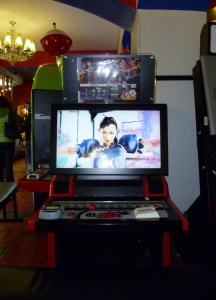
Golfland USA is a mini-golf course first and foremost, and one of the better ones I might add. While I’ve been known to putt a few colored balls in my day, I was really hyped for going here because of the arcade. I was greeted with Super Street Fighter IV Arcade Edition upon walking in. The game was linked with another SSFIVAE cabinet, meaning two players can square off against one another on separate screens. The games had lines to play them, with players racking up impressive wins, sensational combos, and plenty of good-spirited competition.
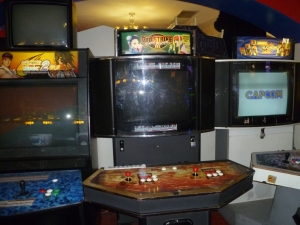
Next to this were three older yet great Capcom fighters: Capcom vs. SNK 2, Street Fighter III: 3rd Strike, and Marvel vs. Capcom 2. Though not in dedicated cabinets like SSFIVAE these are still fighting game staples. I plopped my money in SFIII and got pummeled by Gill (obviously :p), but the game never gets old. These three in a row are like a history lesson in fighting game form. Each had its heyday and have since moved along next to the juggernaut that is SFIV.

Turning around from the 3rd Strike machine I found myself with a game I’ve only seen one other time in arcade form: Super Puzzle Fighter II Turbo. It’s essentially a clone of Puzzle League featuring Street Fighter characters but it’s still damn fun! Oh, and damn hard! Pretty sweet to see the machine sitting across from the bad boys.
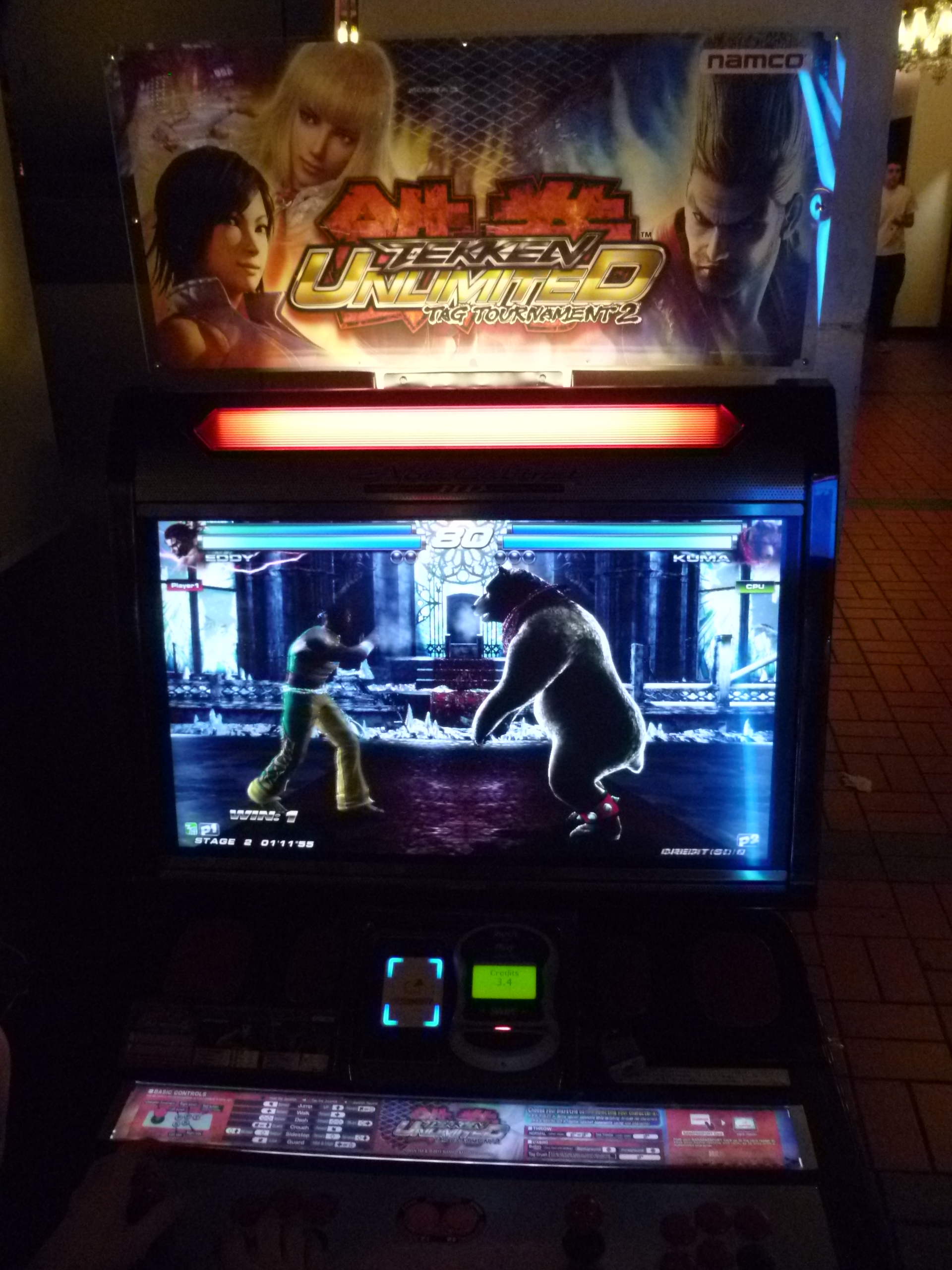
Next to MvC2 was the newest, and last, fighting game available, Tekken Tag Tournament 2 Unlimited. A big fan of Tekken and the first Tag, I was thrilled to see the game here. Actually, this was the first time I’ve ever played TTT2. See here:
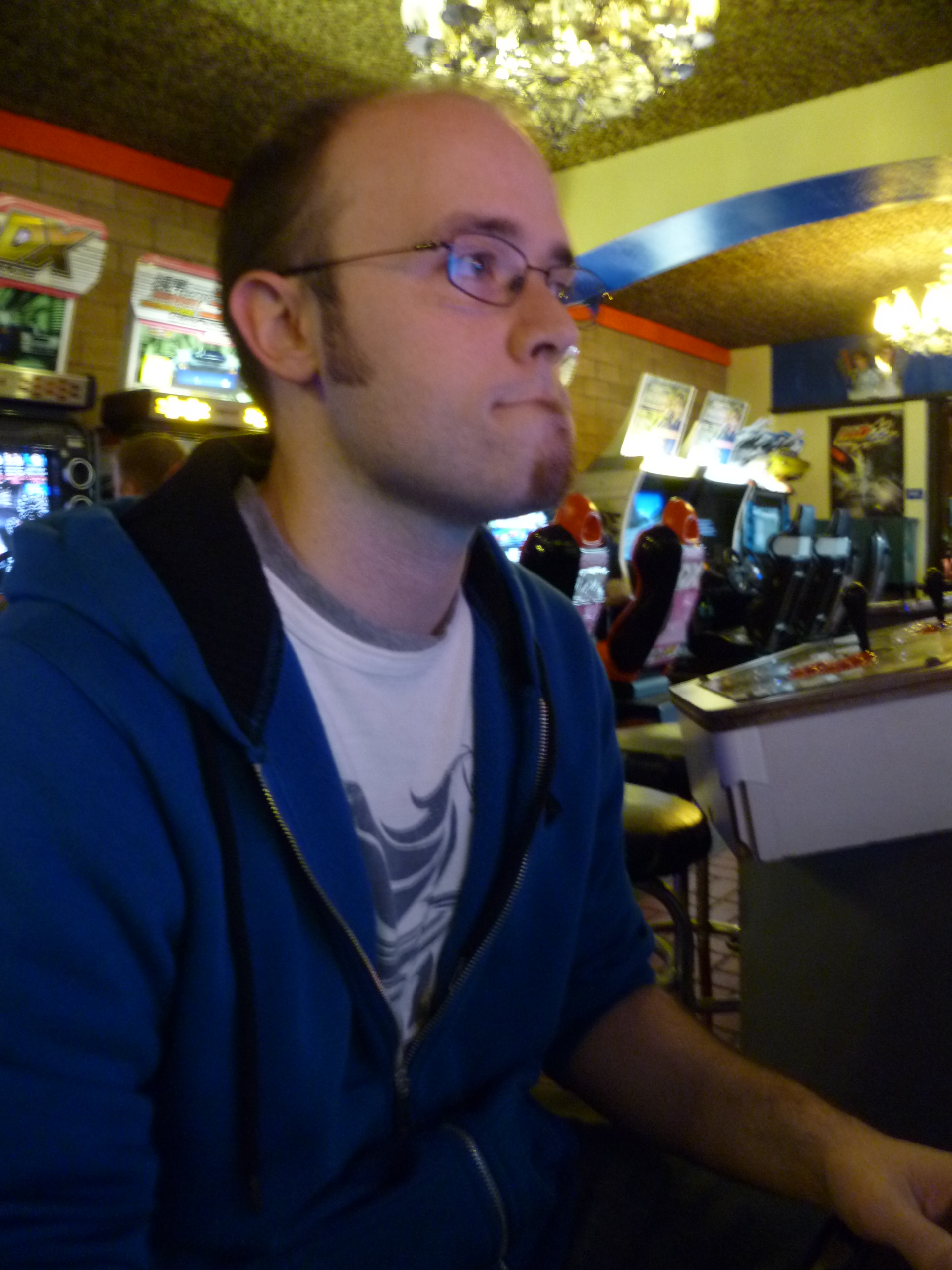
The game is fluid, fast, and fun. Everything Tekken needs to be. I only saw one or two other guys playing this machine while I was visiting. I know Tekken isn’t as popular as Street Fighter, but this game is such a good one it deserves much more love.
So that wraps up the fighting games. The next biggest attraction, at least for me, was the rhythm game section.
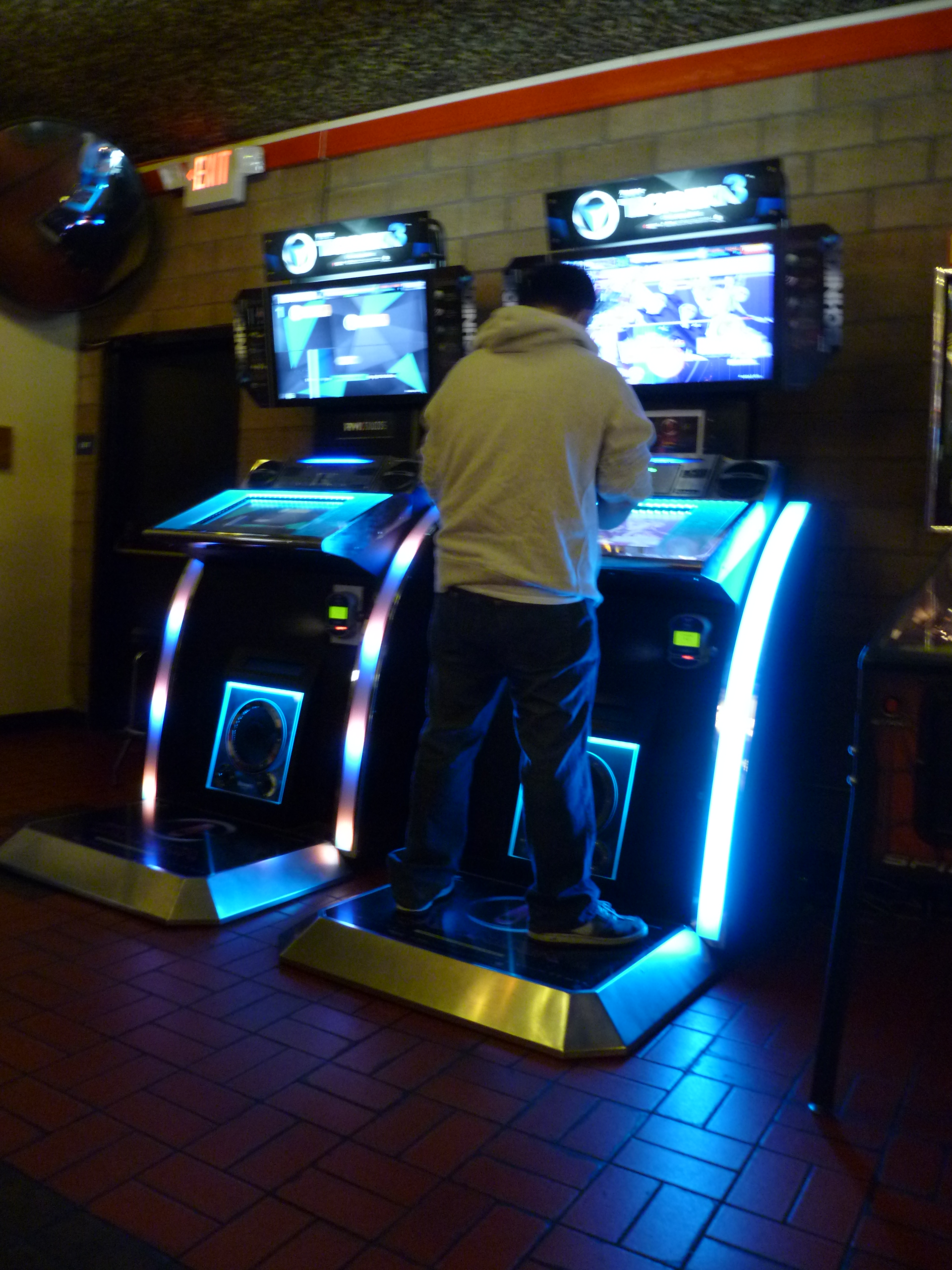
In the corner by Tekken Tag Tournament 2 Unlimited was this crazy loud machine, DJMax Technika 3. Sort of like Pop’n Music but on a really big iPad, DJMax Technika 3 was interesting. You have to use your fingers to tap, slide, and hold notes in beat. Here’s a video:
[youtube http://www.youtube.com/watch?v=NDcpBEH2niQ&w=560&h=315]
On the opposite side of the arcade were all the other rhythm/Bemani games. A notable exception I couldn’t snag a picture of because it was constantly being played was Beatmani IIDX. Not sure which version, but it was a popular one.
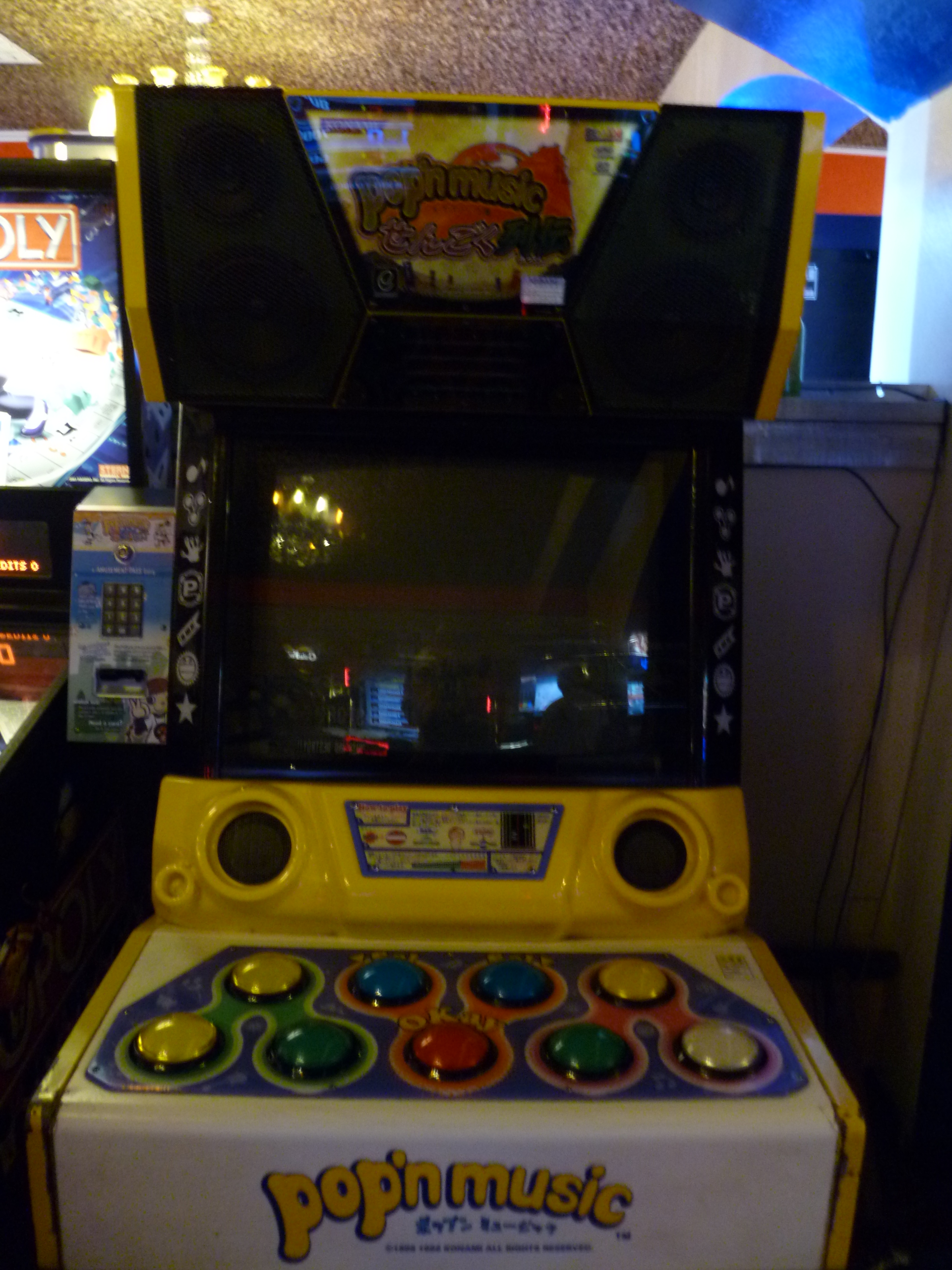
The one game that wasn’t working was the only one I really wanted to play: Pop’n Music. I’ve played the awful Wii release and wished I was playing this instead. It’s hard to find an arcade already, let alone finding one with a quality Japanese game such as this. Hopefully they get this one fixed.
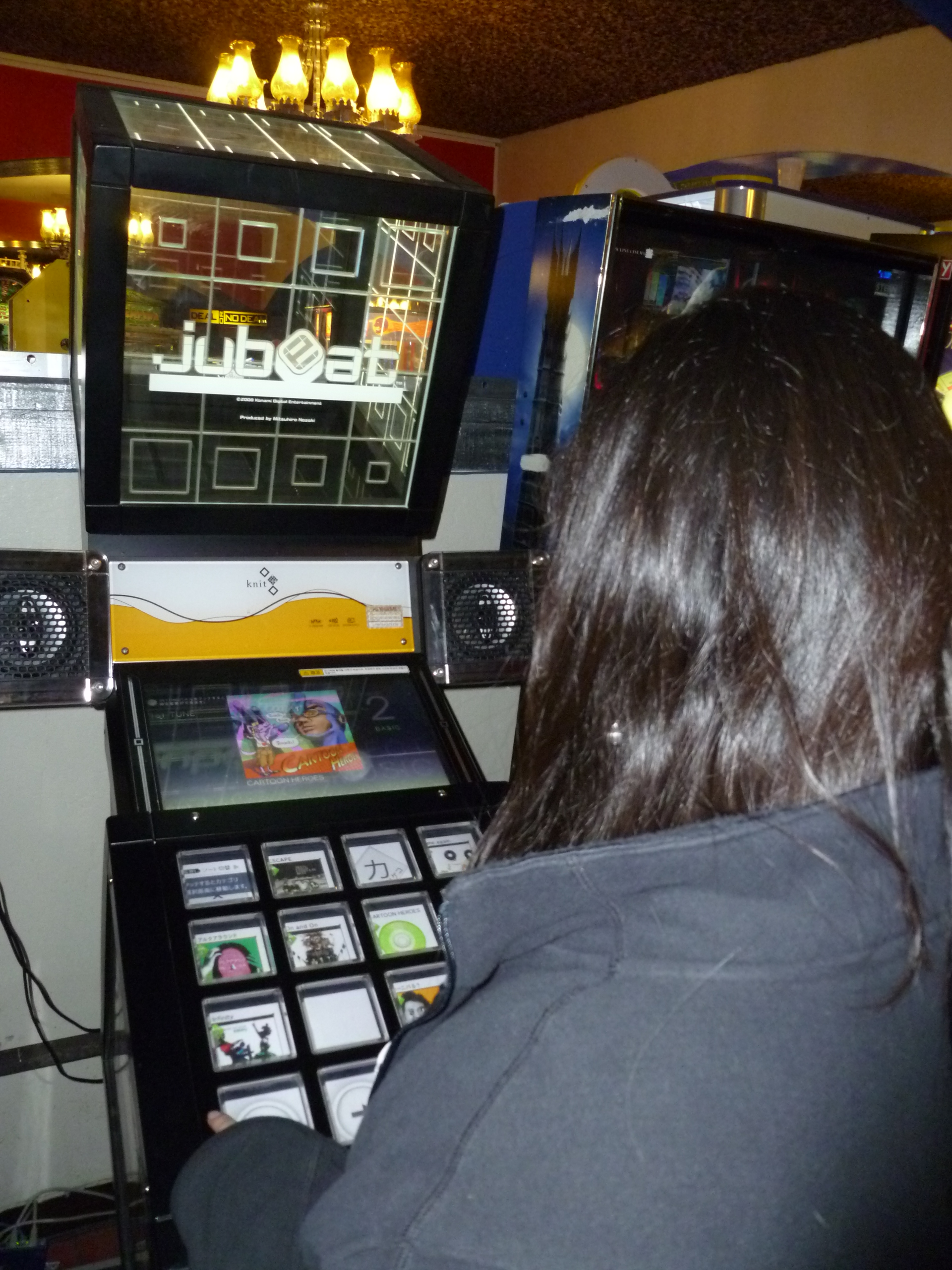
A few cabinets down from Pop’n Music was this weird looking game created by Konami called Jubeat. It uses a dozen small LCD panels that light up with the music and you have to tap the squares in rhythm as you would in other music games. The game featured a lot of music but we still came across a familiar tune:
[youtube http://www.youtube.com/watch?v=wpXqq-KV254&w=560&h=315]
Jubeat was really cool, and one that I’d like to spend more time with should I see it again.
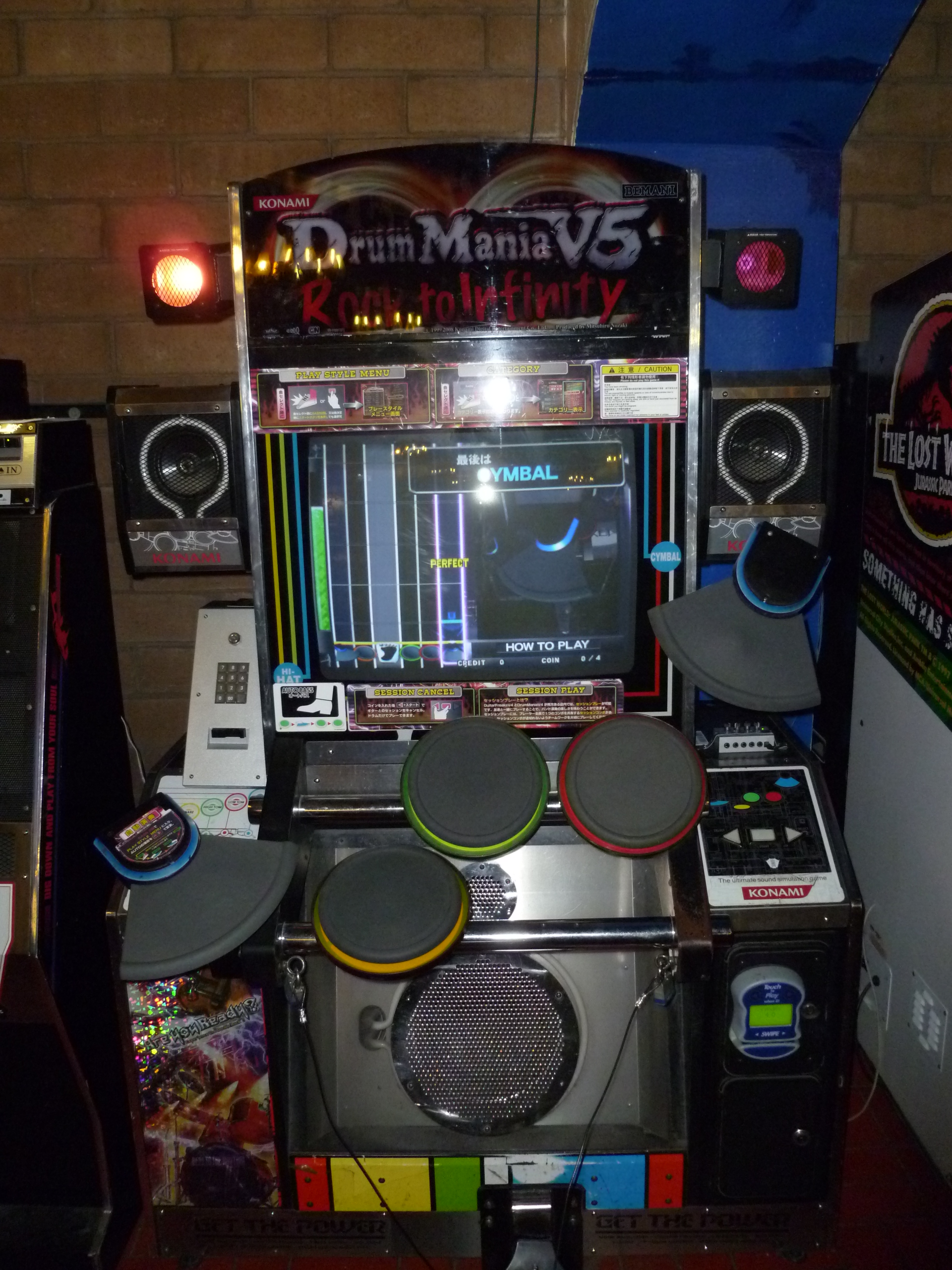
Opposite Jubeat was Drum Mania V5. Along with Guitar Freaks V5 this game makes up what we in America would most closely call Rock Band in arcade form. The game follows a familiar Bemani formula of falling notes that you have to hit in succession. Naturally this one takes the form of a drum set.
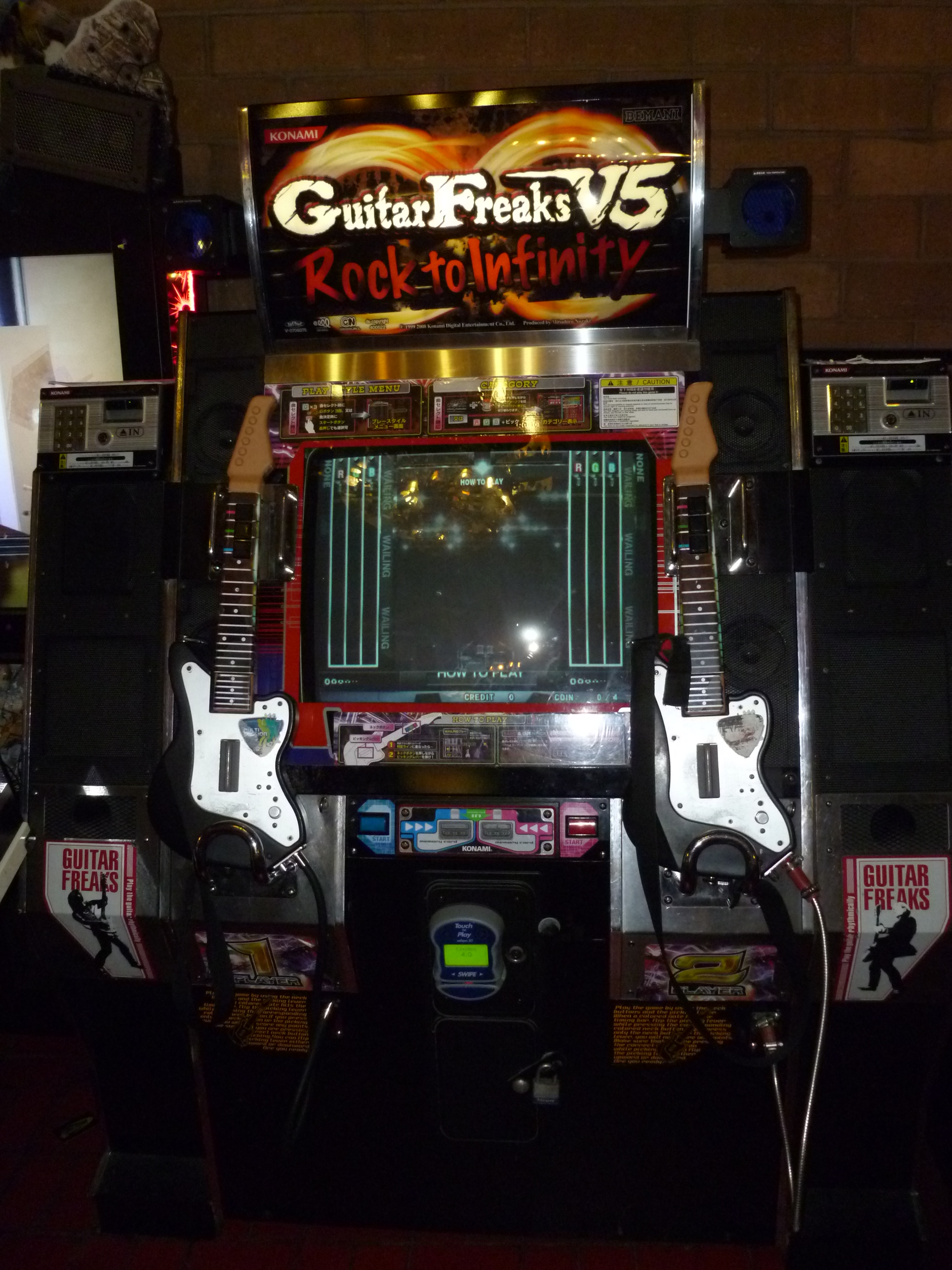
Standing next to Drum Mania V5 is it’s partner game Guitar Freaks V5. Guitar Freaks was the first game to use a guitar controller for gameplay, years before the rise of Guitar Hero and Rock Band. The series is notably more difficult than Guitar Hero by featuring less recognizable songs, at least in my opinion. Next to Guitar Freaks stands the Beatmania IIDX machine, but like I said, I wasn’t able to snap a pic.
While the fighting games line one side of the arcade and the music games the other, the middle houses an assortment of redemption games and skill games. It’s a nice addition to have as it appeals to younger kids looking to score tickets and get some swag to boot. In short, it’s a family place. There’s also a small kitchen that serves snacks and drinks, as well as some benches to take a break and/or host a birthday party should you choose.
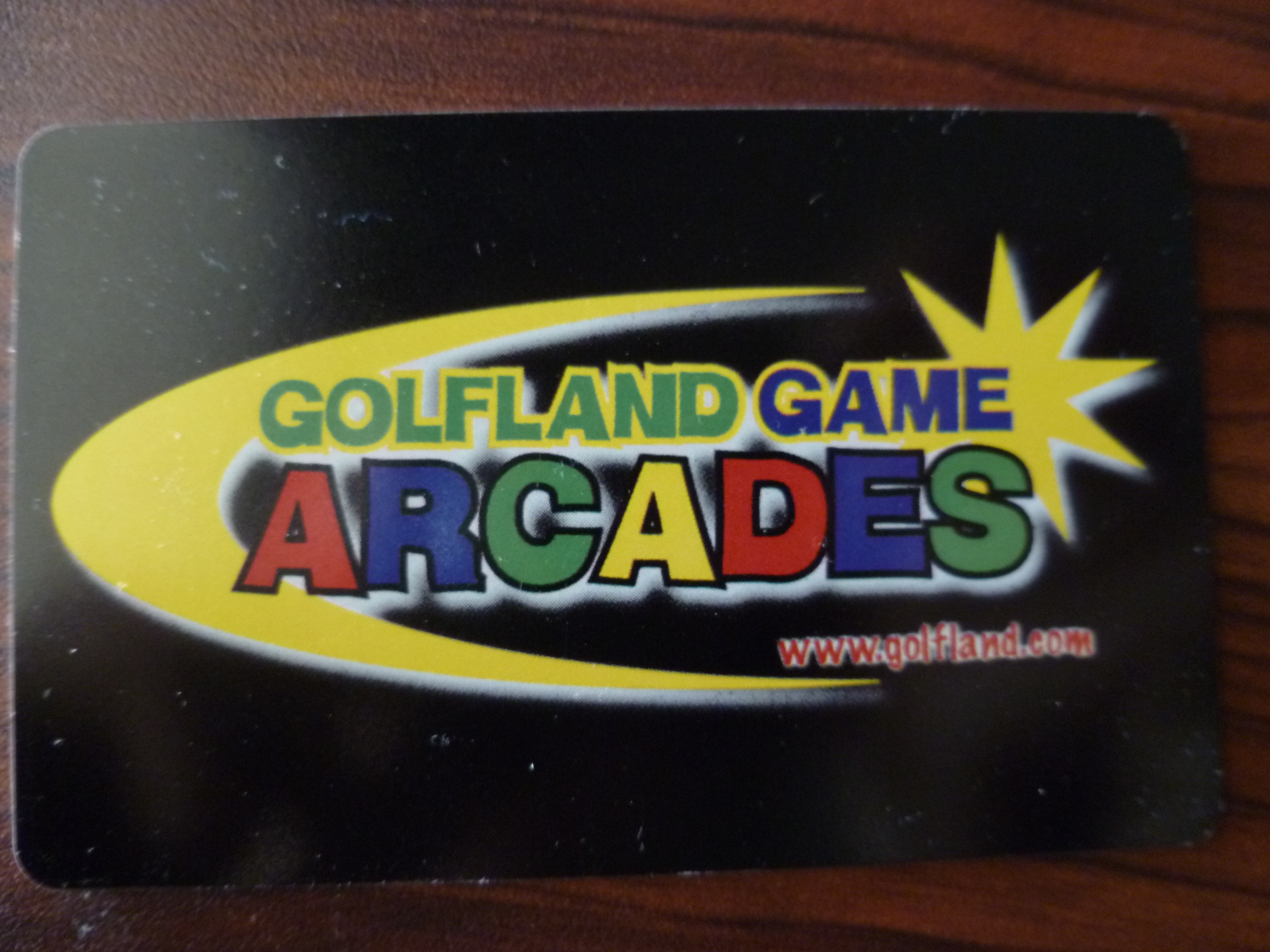
Using cards such as the one above is common in modern arcades. It eliminates the need for consumers to use quarters and it also allows arcade owners to charge just a little bit more for each game. I note the card here because I found them scattered everywhere in the arcade. Gamers would leave them on top of arcade cabinets, on the counter, and even on top of the machine that dispenses them! It’s a sign that many come in the arcade to play and not accrue tickets (which are stored on the card), meaning the arcade spirit is still alive a small bit.
And that’s Golfland USA. As far as arcades go I’ve definitely seen better places. Gameworks in Schaumburg, Illinois had (at least six years ago) an impressive alignment of fighting games and other arcade classics, and there are other bigger places with more to choose from. But for quality Golfland USA had a great number of games that appeal to hardcore gamers. It was great to see up to date versions of the hottest fighters and rhythm games (though no DDR was present), as they are the most profitable games I can imagine. But on the same token it’s a sad picture of the waning arcade industry. Golfland USA is likely one of the last great places for fighting enthusiasts to go and play the arcade games against one another. The industry has moved on so much since then, and, for better or worse, arcades were left behind.

It sounds silly to say, but I felt honored to have been able to play in Sunnyvale. I know I’m a scrub for most fighters and couldn’t hold a candle to the genre’s elite, but I can say I was there. I played the cabinets that some of the world’s best have played. I was in the atmosphere created by fellow gamers in one of the last surviving arcades. I experienced video games that most other people will never have an opportunity to play. I did that. And that feels great to say. Thank you Golfland USA. As I move out to the Sunnyvale area, you can expect a lot more patronage from this gamer.
Laters,
Jsick
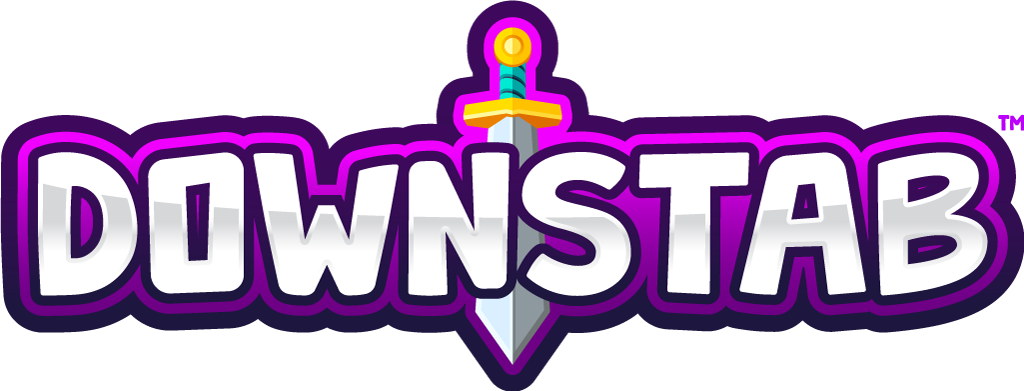





This Post Has 2 Comments
Would u please tell me the address to play jubeat? THX
Thanks for sharing. I have fond memories of visiting up there every summer in the late 90s. It was awesome.
Comments are closed.